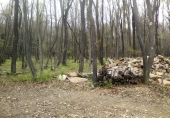
 1
1




 3
3




A build too cool to miss:Mike's GreenhouseA great example:Joseph's Garden
All the soil info you'll ever need:
Redhawk's excellent soil-building series













L. Tims wrote:I kind of had low input natural farming in mind, over acres not just a spot.
A build too cool to miss:Mike's GreenhouseA great example:Joseph's Garden
All the soil info you'll ever need:
Redhawk's excellent soil-building series





 5
5




Trace Oswald wrote:You can build a foot of soil in 5 years just by making a pile of wood chips 5 feet deep and dumping compost and minerals on it over that amount of time
 2
2




Growing on my small acre in SW USA; Fruit/Nut trees w/ annuals, Chickens, lamb, pigs; rabbits and in-laws onto property soon.
Long term goal - chairmaker, luthier, and stay-at-home farm dad. Check out my music! https://www.youtube.com/@Dustyandtheroadrunners




 1
1




A build too cool to miss:Mike's GreenhouseA great example:Joseph's Garden
All the soil info you'll ever need:
Redhawk's excellent soil-building series













L. Tims wrote:I think we're on different wavelengths here Trace. You can't imagine a scenario where you have, say, five acres of land with no subsoil to work with and you have to find a realistic medium between waiting thousands of years for it to build itself and paying a million dollars to have five acres worth of topsoil and compost trucked in?
You aren't gonna get enough woodchips to cover five acres to a depth of one foot, and even if you did there are all sorts of complications that come with that like how well they break down in your climate, erosion and how much soil they actually break down to (not a foot).
As for the minerals, they are there already they just have to be accessed. Decay creates acids which are just as capable of breaking down rock as machinery.
A build too cool to miss:Mike's GreenhouseA great example:Joseph's Garden
All the soil info you'll ever need:
Redhawk's excellent soil-building series





 6
6




It's never too late to start! I retired to homestead on the slopes of Mauna Loa, an active volcano. I relate snippets of my endeavor on my blog : www.kaufarmer.blogspot.com






 4
4




It's never too late to start! I retired to homestead on the slopes of Mauna Loa, an active volcano. I relate snippets of my endeavor on my blog : www.kaufarmer.blogspot.com






 4
4




It's never too late to start! I retired to homestead on the slopes of Mauna Loa, an active volcano. I relate snippets of my endeavor on my blog : www.kaufarmer.blogspot.com














 3
3




It's never too late to start! I retired to homestead on the slopes of Mauna Loa, an active volcano. I relate snippets of my endeavor on my blog : www.kaufarmer.blogspot.com
 1
1




I plant trees in solid rock by smashing a crater and filling in with the rock bits that I smashed out. The area further out than the crater starts to be populated with "weeds" if I water my crater, and thus soil is built. Easily at the rate of an inch per year.
Growing on my small acre in SW USA; Fruit/Nut trees w/ annuals, Chickens, lamb, pigs; rabbits and in-laws onto property soon.
Long term goal - chairmaker, luthier, and stay-at-home farm dad. Check out my music! https://www.youtube.com/@Dustyandtheroadrunners




Growing on my small acre in SW USA; Fruit/Nut trees w/ annuals, Chickens, lamb, pigs; rabbits and in-laws onto property soon.
Long term goal - chairmaker, luthier, and stay-at-home farm dad. Check out my music! https://www.youtube.com/@Dustyandtheroadrunners




Growing on my small acre in SW USA; Fruit/Nut trees w/ annuals, Chickens, lamb, pigs; rabbits and in-laws onto property soon.
Long term goal - chairmaker, luthier, and stay-at-home farm dad. Check out my music! https://www.youtube.com/@Dustyandtheroadrunners
 1
1








Growing on my small acre in SW USA; Fruit/Nut trees w/ annuals, Chickens, lamb, pigs; rabbits and in-laws onto property soon.
Long term goal - chairmaker, luthier, and stay-at-home farm dad. Check out my music! https://www.youtube.com/@Dustyandtheroadrunners






 3
3




It's never too late to start! I retired to homestead on the slopes of Mauna Loa, an active volcano. I relate snippets of my endeavor on my blog : www.kaufarmer.blogspot.com




Su Ba wrote: The ground was initially bulldozed to remove native growth (trees and brush), then ripped & bulldozed to smooth it out into plantable sections.










It's never too late to start! I retired to homestead on the slopes of Mauna Loa, an active volcano. I relate snippets of my endeavor on my blog : www.kaufarmer.blogspot.com

| I agree. Here's the link: http://stoves2.com |



